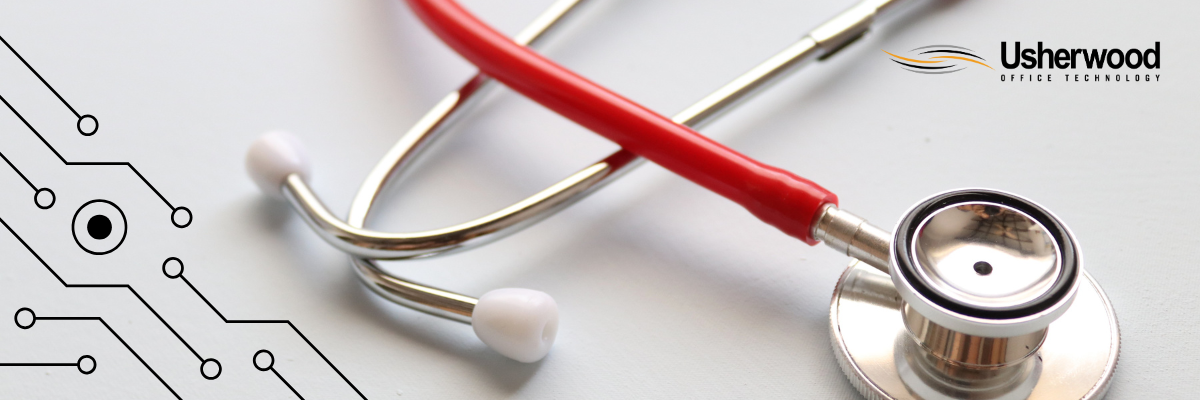By: Jada Sterling, Digital Content Manager on February 4th, 2025
The Ultimate Guide to Data Security in Healthcare
Healthcare is an industry often plagued by cyber threats since hackers know the sensitivity of highly regulated data this industry deals with. Cybercriminals routinely take advantages of healthcare businesses that are unprepared for common social engineering and ransomware attacks.
If you've been tasked with improving cybersecurity at your healthcare business, you're in luck. There are many IT providers specializing in healthcare cybersecurity, offering many common safeguards that can bolster your defenses.
Here's your complete guide to healthcare IT security, best practices, and different areas of data security to consider with your strategy.
The Importance of Cybersecurity in Healthcare
You likely already know that healthcare is a common target for hackers due to HIPAA regulations raising the stakes of data breaches. However, you might not have considered the unique consequences of successful breaches in healthcare.
Cybercriminals now have the ability to shut down critical systems within healthcare facilities, including security systems, HVAC, and even different machines hooked up to the network. This not only endangers data - it puts patient safety and care at risk.
To read more about the dangers of cyber incidents in the healthcare field, check out our blog: Is Cybersecurity Really That Big of a Deal In Healthcare? Risks of Healthcare Data Breaches
Internet of Things in Health-Related Fields
Just like in fields like manufacturing, tools have advanced as a part of the Internet of Things, or the interconnectedness of different medical devices on your network.
Hackers often take advantage of network endpoints, or any device that connects to your business network. Many times, these devices don't come with the same cybersecurity safeguards as devices like computers would.
So, in theory, a cybercriminal could exploit something like a smart fridge or printer to gain access to your network. This makes healthcare businesses especially vulnerable the more smart devices they have connected to their business network.
Healthcare Cybersecurity Best Practices
There are many proven methods to stop cybercriminals in their tracks before they can compromise your network.
Some common cybersecurity best practices include implementing multifactor authentication (MFA), strong password policies, and spreading awareness of social engineering through phishing training.
1. MFA
Multifactor Authentication is a common tool for preventing unauthorized access to a network. It requires users to utilize either something they have, something they know, or something they are to prove their identity. Different elements of multifactor authentication include:
- Mobile security applications
- Biometric elements like facial recognition or fingerprints
- Security questions
- Personal phone numbers
2. Strong Passwords & Frequent Resets
Passwords are one of the simplest methods to mitigate the risk of security breaches. Not only should you require strong passwords with many varying and non-repeating characters, but everyone in your organization should reset passwords often.
You can set up these requirements with your IT provider, and users will be prompted to reset passwords after set time periods you select.
3. Cybersecurity Awareness Training
Another major benefit of healthcare IT security companies is that they can provide cybersecurity training. Among the various healthcare cybersecurity threats, human error is the biggest cause of cyber attacks.
Social engineering tactics like phishing and fraudulent phone calls, texts, and other communications are a huge security risk. With AI increasing the sophistication of these attacks, it's not as easy to spot fake senders or questionable messages.
To read more about the warning signs of phishing attacks, check out our blog: SLAM Dunk Your Email Security with These 4 Rules to Live By
HIPAA Compliance and Digital Communications
Mitigating the risks of human error goes deeper than providing awareness training. Protecting patient data in the healthcare sector also requires strict policies for digital communications. How do you configure file management permissions to keep Electronic Health Records (EHR) safe from unauthorized access?
You may ask yourself if any singular platform is more compliant than the rest. The reality of modern-day healthcare systems and the emergence of telehealth is that digital transformation has become the norm.
Because of this, it takes active and intentional data access control policies to protect medical records and remain HIPAA compliant. To learn more about how to utilize unified communications platforms to make them compliant, check out our blog: Is Microsoft Teams HIPAA Compliant?
Securing Your Healthcare Print Environment
Most network breaches happen due to attacks on network endpoints. These include any devices that connect to your business network. Experts have found that printers can be susceptible to cyber attacks via compromised microchips in toner cartridges.
Because of this, it's crucial that you invest in printers that are secure by design, meaning they are equipped to detect and mitigate cyber threats. This type of endpoint security technology is sometimes referred to as Endpoint Detection and Response.
Read more about printer security in healthcare in our blog: Healthcare Data Breaches: Does Your Printer Put You At Risk?
How to Find Quality IT Support for Medical Practices
Now that you have an overview of healthcare cybersecurity, you may wonder how other businesses in the field implement the necessary tools and policies. To ensure you are compliant and secure, it's wise to consider specialized managed IT services for healthcare businesses.
Healthcare cybersecurity services can be a game-changer in preparing your business to deal with cyber attacks. To learn more about how these services can optimize and secure your network to mitigate data loss in the event of attacks, click the button below to speak with an IT expert.
Read On

Is Cybersecurity Really That Big of a Deal In Healthcare? Risks of Healthcare Data Breaches
If your small to medium-sized healthcare clinic uses digital records, odds are you may be at risk...

New York State Attorney General Setting Stage for Stricter Business Cybersecurity Regulations
If you’re considering upgrading your business' cybersecurity due to the rise of cybercrime, you may...

Healthcare Data Breaches: Does Your Printer Put You At Risk?
Of all the devices that we know can be hacked, you might not have considered your printer to be one...




